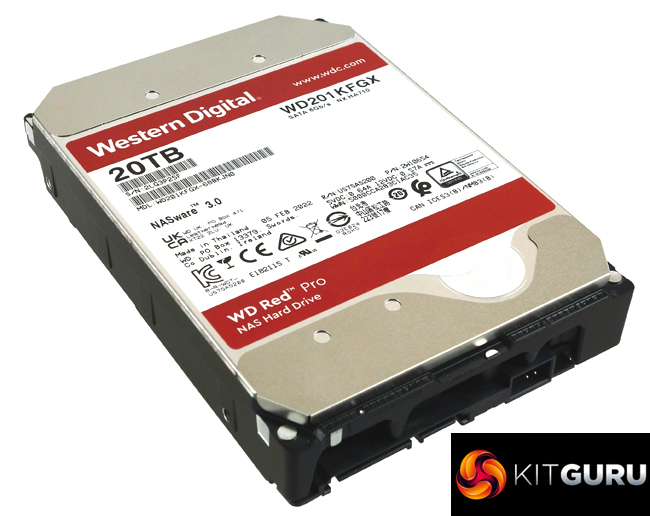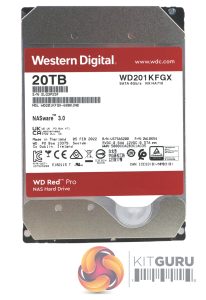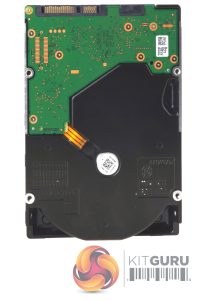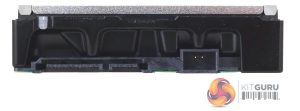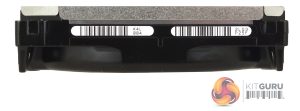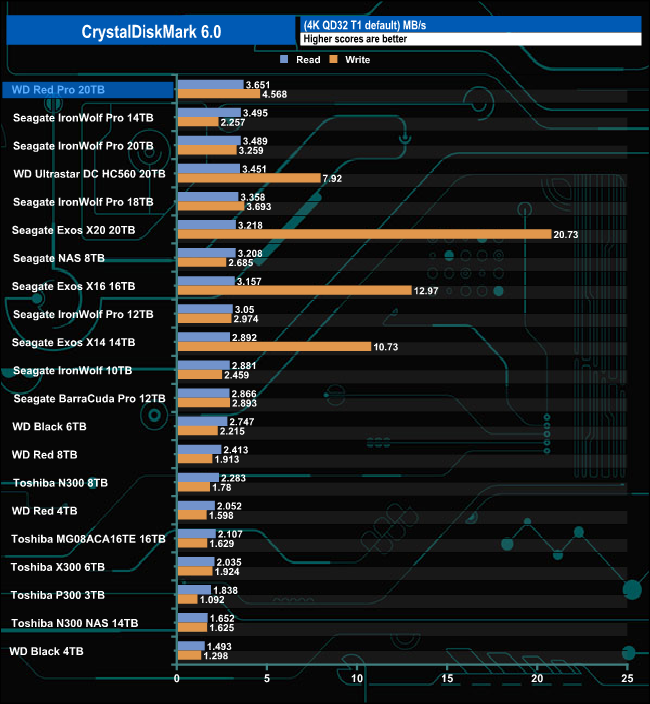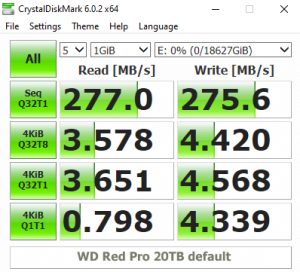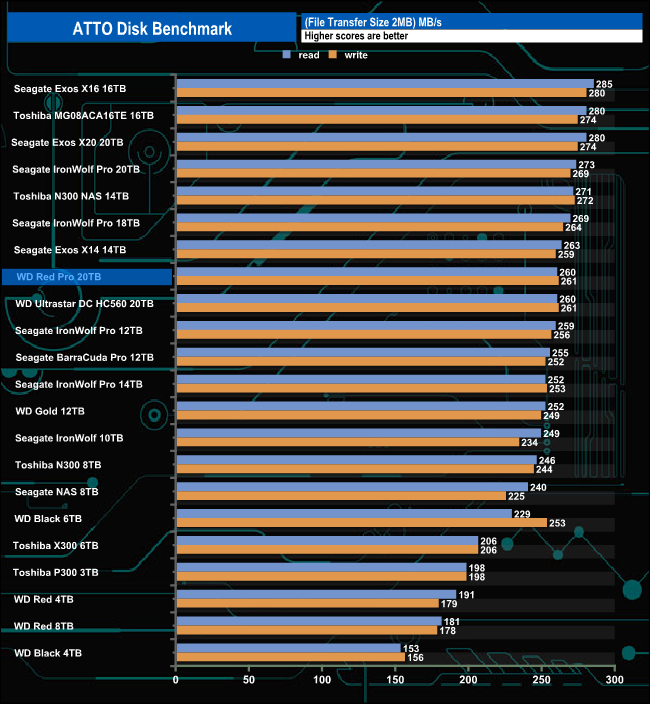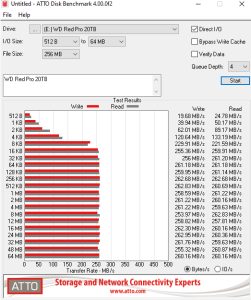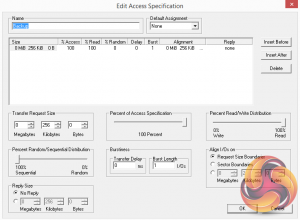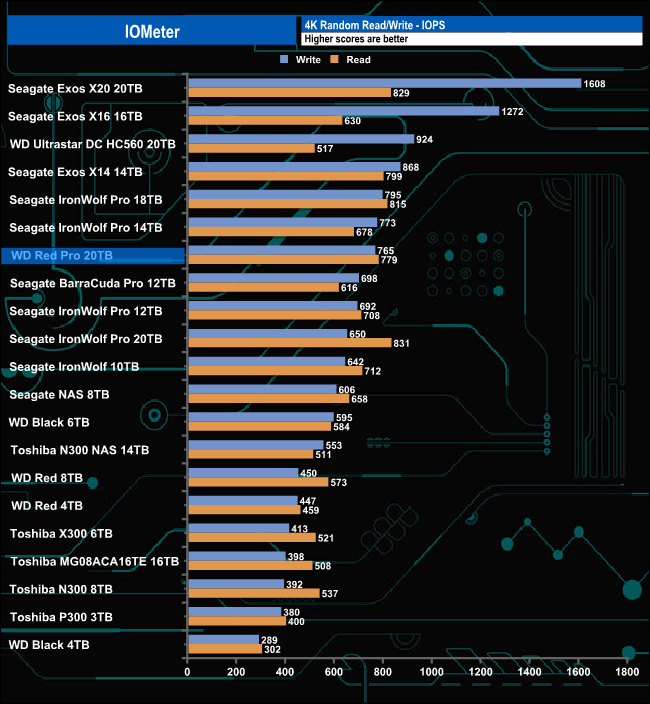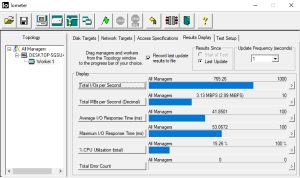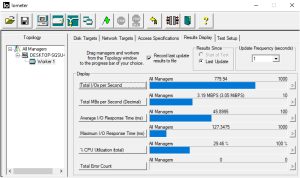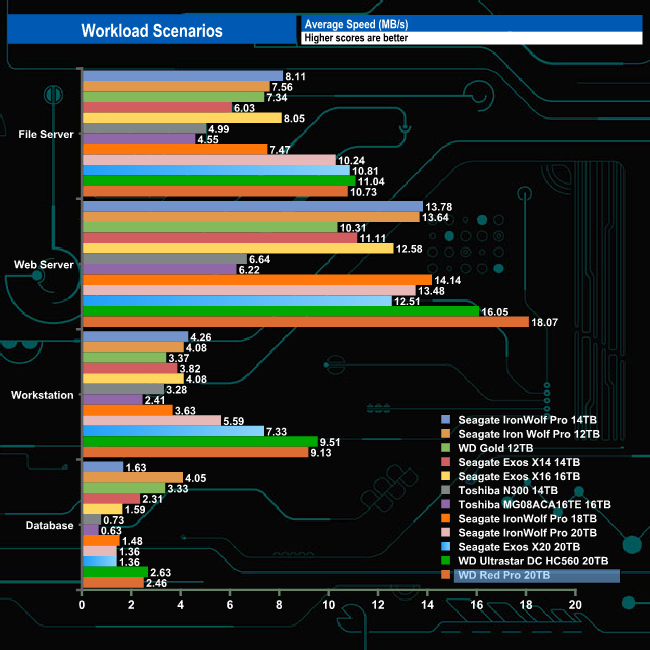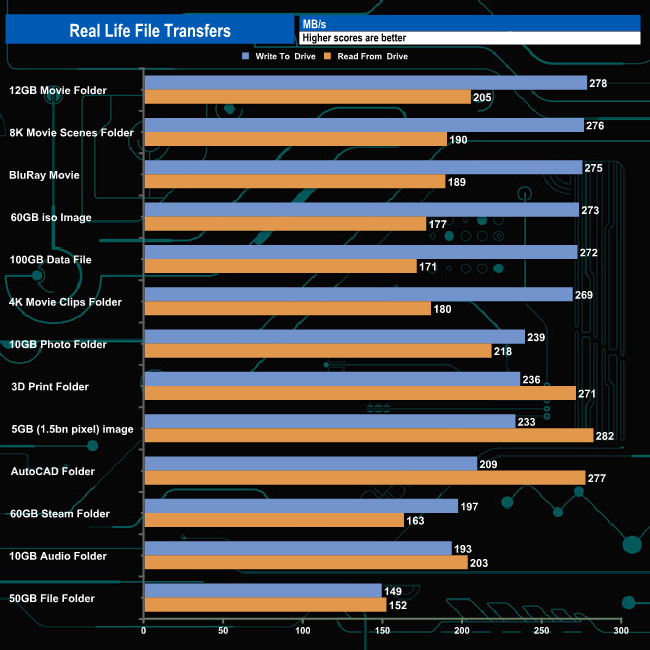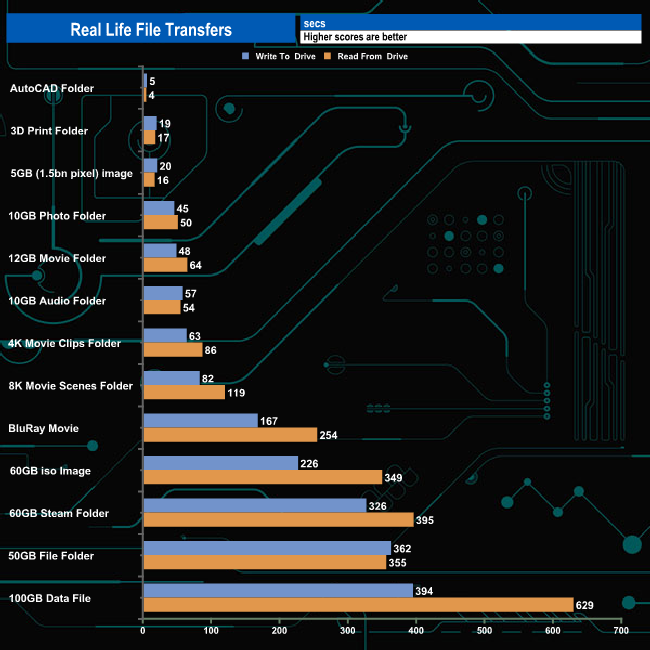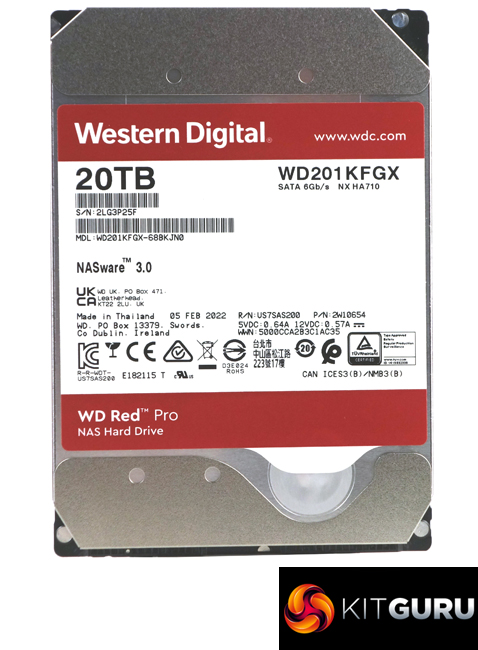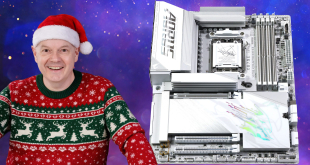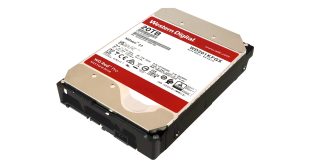
WD has recently added a new flagship HDD drive to their NAS orientated Red Pro range, in the form of a huge 20TB capacity model. It features WD's latest technologies for CMR hard drives, including OptiNAND, ePMR and triple-stage actuator technology, as well as the more NAS-focused features that the Red Pro product line brings, such as the company's NASware 3.0 technology.
The 20TB Red Pro (WD201KFGX) makes use of WD's latest nine disk platform, with each of the 2.2TB discs having an areal density of 1,131 Gbits/sq² along with eighteen heads. It has a spindle speed of 7,200rpm, a 4.16ms average latency and an impressive 512MB of cache. WD quote a maximum sustained transfer rate of 268MB/s for the drive, which is 4MB/s slower than the quoted transfer rate of the previous flagship 18TB Red Pro drive.
The official power consumption figures for the drive are 6.9W when operating, 3.8W when idle and 1.6W when in standby and sleep modes, all three of which are slightly increased from the 6.1W, 3.6W and 0.9W respectively of the 18TB version of the Red Pro.
WD quote a workload figure of up to 300TB/year for the 20TB drive (the whole Red Pro range has the same workload figure) and back it with a 5-year warranty.
Physical Specifications:
- Usable Capacities: 20TB.
- Spindle Speed: 7,200rpm.
- No. Of Platters: 9.
- No. Of Heads: 18.
- Cache: 512MB.
- Recording Method: ePMR (Energy-Assisted Perpendicular Magnetic Recording).
- Interface: Serial ATA (SATA) 6Gb/s (SATA III).
- Form Factor: 3.5in.
- Dimensions: 26.1 x 147 x 101.6mm.
- Drive Weight: 69g.
Firmware Version: 83.00A83.
WD’s 20TB Red Pro is built on a standard 3.5in footprint but the height has been increased to 26.1mm to accommodate the number of disks and actuators the drive uses. The drive has a spindle speed of 7,200rpm and there is an impressive 512MB of cache.
The drive uses 6th Gen WD HelioSeal Helium technology enabling the enclosure to hold nine 2.2TB aluminium discs along with eighteen heads. The drive uses Energy-Assisted Perpendicular Magnetic Recording (ePMR) and triple-stage actuator (TSA) technologies which help combat the threat of magnetic inter-track interference (ITI) which can be a real problem with the high areal density disks the drive is using.
We also find various NAS-focussed features and technologies. The most important of these is NASware 3.0 Technology. NASware is firmware that improves the overall reliability and performance of the drive. It uses intelligent error recovery to prevent hard drives from being dropped off the RAID due to extended error recovery which reduces the downtime needed to rebuild the RAID array. It also optimises the power requirements of the drive which can help reduce power consumption and can help to improve drive performance and reliability by reducing the temperature of the drive.
To help the drive survive the hostile environment of larger NAS enclosures (the Red Pro line supports up to 24 bay units) the drive is equipped with a multi-axis shock sensor that detects subtle shocks and dynamic fly height technology which adjusts each read-write function to compensate and protect the data. 3D Active Balance Plus ensures that the drive is properly balanced which helps lessen vibration, something that can cause major problems in large multi-disk environments, which in turn reduces noise levels.
For testing, the drives are all wiped and reset to factory settings by HDDerase V4. We try to use free or easily available programs and some real-world testing so you can compare our findings against your own system. This is a good way to measure potential upgrade benefits.
Main system:
Intel Core i7-7700K with 16GB of DDR4-3200 RAM, Sapphire R9 390 Nitro and an Asus Prime Z270-A motherboard.
Other drives
Seagate NAS 8TB
Seagate Exos X16 16TB
Seagate Exos X14 14TB
Seagate Exos X20 20TB
Seagate IronWolf Pro 14TB
Seagate BarraCuda Pro 12TB
Seagate IronWolf Pro 12TB
Seagate IronWolf Pro 18TB
Seagate IronWolf Pro 20TB
Seagate IronWolf 10TB
Toshiba MG08ACA16TE 16TB
Toshiba N300 8TB
Toshiba NAS N300 14TB
Toshiba P300 3TB
Toshiba X300 6TB
WD Ultrastar DC HC560
WD Gold 12TB
WD Black 6TB
WD Black 4TB
WD Red 4TB
WD Red 8TB
Software:
Atto Disk Benchmark.
CrystalMark 6.0.0.
IOMeter.
All our results were achieved by running each test five times with every configuration this ensures that any glitches are removed from the results.
CrystalDiskMark is a useful benchmark to measure theoretical performance levels of hard drives and SSD’s. We are using V6.0.0. to test HDD drives.
In the CrystalDiskMark 4K QD32 T1 test, the 20TB WD Red posted the best read score to date for a mechanical hard drive of 3.651MB/s. Its write performance of 4.568MB/s is also impressive but is some way behind the other 20TB WD drive we've recently reviewed, the enterprise focussed Ultrastar DC HC560.
The ATTO Disk Benchmark performance measurement tool is compatible with Microsoft Windows. Measure your storage system's performance with various transfer sizes and test lengths for reads and writes. Several options are available to customize your performance measurement including queue depth, overlapped I/O and even a comparison mode with the option to run continuously. Use ATTO Disk Benchmark to test any manufacturer's RAID controllers, storage controllers, host adapters, hard drives and SSD drives and notice that ATTO products will consistently provide the highest level of performance to your storage.
The official performance rating of the drive is up to 269MB/s. We couldn't hit that maximum figure with the ATTO benchmark but with a read result of 260MB/s with writes at 261MB/s, we were certainly in the ballpark.
IOMeter is another open-source synthetic benchmarking tool that is able to simulate the various loads placed on a hard drive and solid-state drive technology.
We test with both random read and write 4k tests, as shown above. There are many ways to measure the IOPS performance of a hard drive, so our results will sometimes differ from the manufacturer’s quoted ratings. We do test all drives in exactly the same way, so the results are directly comparable.
The 20TB Red Pro's 4K random write result of 766 IOPS sees it into the top 10 HDD drives we've tested to date. Its random read figure of 779 IOPS is faster than WD's 20TB Ultrastar DC HC560 drive but at 924 IOPS, the enterprise drive has a much better write performance figure than the Red Pro.
In our throughput tests, the reads peaked at 287MB/s (4MB block) which is 19MB/s faster than the official figure although by the end of the test run the figure had dropped to 248.33MB/s. Writes peaked further back at the 1MB block mark at 278.30MB/s, also faster than the official figure before dropping back to finish the test run at 266.14MB/s.
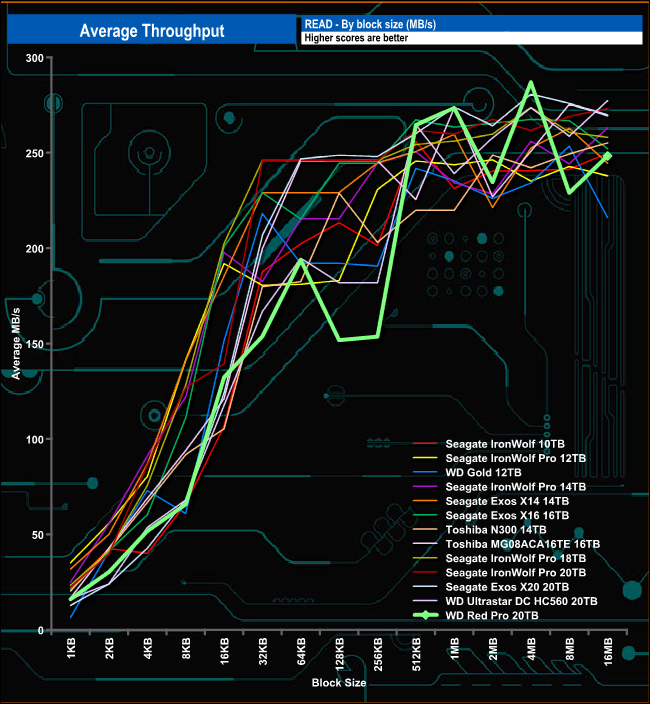
The 20TB Red Pro's peak read result of 287MB/s is the fastest for an HDD we’ve seen to date when it comes to read throughput.
The WD Red Pro's write performance isn't as good as the read, peaking at 278.30MB/s.
We tested the 20TB Red Pro with a number of scenarios that it may face in the real world. The settings for these scenarios are as follows.
File Server
512MB file size, 16KB Block size
80% Read 20% Write 100% Random
I/O queue depth 128
Web Server
1GB file size, 16KB Block size
100% Read 0% Write 100% Random
I/O queue depth 64
Database
2GB file size, 4KB Block size
90% Read 10% Write, 90% Random, 10% Sequential
I/O depth 128
Workstation
1GB file size, 16KB Block size
70% Read 30% Write, 100% Random, 0% Sequential
I/O depth 6
The 20TB WD Red Pro produced the fastest performance (18.07MB/s) for a mechanical drive we’ve seen to date for the Web Server test. It produces very strong performance for the other three tests as well.
To test real-life performance of a drive we use a mix of folder/file types and by using the FastCopy utility (which gives a time as well as MB/s result) we record the performance of the drive reading from & writing to a 256GB Samsung SSD850 PRO.
We use the following folder/file typesL
- 100GB data file.
- 60GB iso image.
- 60GB Steam folder – 29,521 files.
- 50GB File folder – 28,523 files.
- 12GB Movie folder – (15 files – 8 @ .MKV, 4 @ .MOV, 3 @ MP4).
- 10GB Photo folder – (304 files – 171 @ .RAW, 105 @ JPG, 21 @ .CR2, 5 @ .DNG).
- 10GB Audio folder – (1,483 files – 1479 @ MP3, 4 @ .FLAC files).
- 5GB (1.5bn pixel) photo.
- BluRay Movie – 42GB.
- 21GB 8K Movie demos – (11 demos)
- 16GB 4K Raw Movie Clips – (9 MP4V files).
- 4.25GB 3D Printer File Folder – (166 files – 105 @ .STL, 38 @ .FBX, 11 @ .blend, 5 @ .lwo, 4 @ .OBJ, 3@ .3ds).
- 1.5GB AutoCAD File Folder (80 files – 60 @ .DWG and 20 @.DXF).
The 20TB WD Red Pro produced very consistent performance when it came to handling the larger file sizes with an average write figure for the seven large file transfers of 268.86MB/s. The fastest write performance was the 12GB Movie Folder at 278MB/s while the fastest read speed came from the 5GB image transfer at 282MB/s. The slowest of the file transfers was the 50GB File Folder, full of small bity files, with writes at 149MB/s and reads at 152MB/s.
WD has recently added 20TB capacity drives to a number of their HDD product lines. One of these is the NAS focused Red Pro range which officially supports NAS devices using up to 24 bays in size. The drive features a number of WD's current HDD technologies as well as more NAS-focused Red Pro features and uses WD's latest nine disk platform. The 20TB Red Pro has a spindle speed of 7,200rpm and comes with 512MB of cache.
Each 2.2TB disc has an areal density of 1,160 Gbits/in² and to overcome the potential track problems caused by such dense discs, the drive uses two WD technologies; triple-stage actuator (TSA) and Energy-Assisted Perpendicular Magnetic Recording (ePMR). TSA uses three pivot points in the actuator arm to more accurately position the head over the data track. ePMR is a technology to overcome something called jitters. Jitters occur when the write current at the recording head is flipped from one direction to another, ePMR applies a constant electrical current to the main pole of the write head throughout the write process, producing a more consistent, preferred signal path that helps to reduce jitter. Reducing jitters allows for the reduction of space between bits written which in turn allows for greater areal densities and larger capacities.
As with the Ultrastar DC H560, we reviewed recently, the 20TB Red Pro uses WD's OptiNAND technology. OptiNAND technology is a flash-enhanced drive technology developed by WD that integrates an iNAND UFS embedded flash drive (EFD), using 3D NAND, that sits on the hard drive PCB. The NAND isn't used to store user data as per the hybrid drives of the past but instead is used to store the self-generated drive metadata instead of holding it on the disks themselves, freeing up more usable space.
Having said that, user data isn't stored in the NAND, except for one situation where it is – sudden power loss. If power is lost during the write process the SoC uses the rotational power of the still spinning disks to power up internal capacitors until any cached data transfers to the non-volatile NAND.
WD quote a sustained transfer rate of 268MB/s for the 20TB Red Pro which is very slightly slower than the 18TB version. When tested with the ATTO benchmark we could confirm that figure with test results of 260MB/s and 261MB/s for Sequential read and writes respectively. The drive also performed very well in our workload scenarios, producing the best performance figures we’ve seen to date for an HDD in the File Server test.
The official workload rate for the 20TB Red Pro is 300TB/year, which is the figure for the whole Red Pro range from the 2TB model upwards. WD back the Red Pro with a 5-year warranty.
We found the 20TB version of the Red Pro for £612.99 (inc VAT) on WD's online shop HERE.
Discuss on our Facebook page HERE.
Pros
- Overall performance.
- Drive technologies.
- NAS focussed features.
Cons
- All that technology doesn't come cheap.
KitGuru says: WD's 20TB Red Pro drive combines some of WD's latest thinking on CMR hard drive technology, alongside the long-standing NAS feature set of the Red Pro product line. But, and it's a pretty big but, it does come with a hefty price tag.
 KitGuru KitGuru.net – Tech News | Hardware News | Hardware Reviews | IOS | Mobile | Gaming | Graphics Cards
KitGuru KitGuru.net – Tech News | Hardware News | Hardware Reviews | IOS | Mobile | Gaming | Graphics Cards


